 W
WThis is a list of mythological characters who appear in narratives concerning the Trojan War.
 W
WIn Greco-Roman mythology, Aeneas was a Trojan hero, the son of the Trojan prince Anchises and the Greek goddess Aphrodite. His father was a first cousin of King Priam of Troy, making Aeneas a second cousin to Priam's children. He is a character in Greek mythology and is mentioned in Homer's Iliad. Aeneas receives full treatment in Roman mythology, most extensively in Virgil's Aeneid, where he is cast as an ancestor of Romulus and Remus. He became the first true hero of Rome. Snorri Sturluson identifies him with the Norse god Vidarr of the Æsir.
 W
WIn Greek mythology, Aesacus or Aisakos was a son of King Priam of Troy. Aesacus sorrowed for the death of his wife or would-be lover, a daughter of the river Cebren, and was transformed into a bird.
 W
WIn Greek mythology, Amykos, Latinized as Amycus, was the king of the Bebryces, a mythical people in Bithynia.
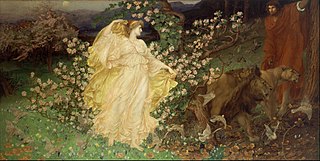 W
WAnchises was a member of the royal family of Troy in Greek and Roman legend. He was said to have been the son of King Capys of Dardania and Themiste, daughter of Ilus, who was son of Tros. He is most famous as the father of Aeneas and for his treatment in Virgil's Aeneid. Anchises' brother was Acoetes, father of the priest Laocoön.
 W
WIn Greek mythology, Andromache was the wife of Hector, daughter of Eetion, and sister to Podes. She was born and raised in the city of Cilician Thebe, over which her father ruled. The name means 'man battler' or 'fighter of men' or 'man fighter' or 'man's battle', from the Greek stem ἀνδρ- 'man' and μάχη 'battle'.
 W
WIn Greek mythology, Astyanax was the son of Hector, the crown prince of Troy, and his wife, Princess Andromache of Cilician Thebe. His birth name was Scamandrius, but the people of Troy nicknamed him Astyanax, because he was the son of the city's great defender and the heir apparent's firstborn son.
 W
WBrisēís, also known as Hippodámeia, is a significant character in the Iliad. Her role as a status symbol is at the heart of the dispute between Achilles and Agamemnon that initiates the plot of Homer's epic. She was married to Mynes, a son of the King of Lyrnessus, until Achilles sacked her city and enslaved her shortly before the events of the poem. Being forced to give Briseis to Agamemnon, Achilles refused to reenter the battle.
 W
WCassandra or Kassandra, , was a Trojan priestess of Apollo in Greek mythology cursed to utter true prophecies, but never to be believed. In modern usage her name is employed as a rhetorical device to indicate someone whose accurate prophecies are not believed.
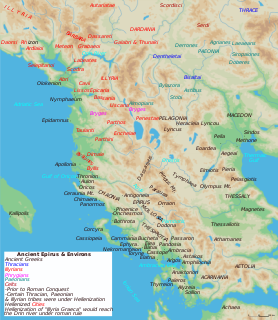 W
WChaon in Greek mythology was a Greek hero, notable for his return from Troy, and the eponymous ancestor of the Chaonians, who gave his name to ancient Chaonia, a district which is now located in northwestern Epirus, Greece and Southern Albania near the border with Greece. The stories are unclear as to whether he was the friend or the brother of Helenus, but in either case, he accompanied him to the court of Neoptolemus. The stories concerning Chaon's death are as unclear as that of his relationship to Helenus. Chaon was either killed in a hunting accident or offered himself as a sacrifice to the gods during an epidemic, thus saving the lives of his countrymen. In either case, when Helenus became the ruler of the country, he named a part of the kingdom after Chaon.
 W
WIn Greek mythology, Chryseis is a Trojan woman, the daughter of Chryses. Chryseis, her apparent name in the Iliad, means simply "Chryses' daughter"; later writers give her real name as Astynome (Ἀστυνόμη). The poet Tzetzes describes her to be "very young and thin, with milky skin; had blond hair and small breasts; nineteen years old and still a virgin".
 W
WIn Greek mythology, Chryses was a Trojan priest of Apollo at Chryse, near the city of Troy.
 W
WCressida is a character who appears in many Medieval and Renaissance retellings of the story of the Trojan War. She is a Trojan woman, the daughter of Calchas, a Greek seer. She falls in love with Troilus, the youngest son of King Priam, and pledges everlasting love, but when she is sent to the Greeks as part of a hostage exchange, she forms a liaison with the Greek warrior Diomedes. In later culture she becomes an archetype of a faithless lover.
 W
WIn Greek mythology, Creusa was the daughter of Priam and Hecuba. She was the first wife of Aeneas and mother to Ascanius.
 W
WThe Dardanelles, also known as Strait of Gallipoli from Gallipoli Peninsula or from Classical Antiquity as the Hellespont (; Classical Greek: Ἑλλήσποντος, romanized: Hellēspontos, lit. 'Sea of Helle'), is a narrow, natural strait and internationally significant waterway in northwestern Turkey that forms part of the continental boundary between Europe and Asia, and separates Asian Turkey from European Turkey. One of the world's narrowest straits used for international navigation, the Dardanelles connects the Sea of Marmara with the Aegean and Mediterranean seas, while also allowing passage to the Black Sea by extension via the Bosphorus. The Dardanelles is 61 kilometres (38 mi) long, and 1.2 to 6 kilometres wide, averaging 55 metres (180 ft) deep with a maximum depth of 103 metres (338 ft) at its narrowest point abreast the city of Çanakkale.
 W
WThe Dardanoi in classical writings were a people closely related to the Trojans, an ancient people of the Troad, located in northwestern Anatolia. The Dardanoi derived their name from Dardanus, the mythical founder of Dardania, an ancient city in the Troad. Rule of the Troad was divided between Dardania and Troy. Homer makes a clear distinction between the Trojans and the Dardanoi.
 W
WDardanus was an ancient city in the Troad. It was sometimes called Dardania, a term used also for the district around it. Pliny the Elder called it Dardanium.
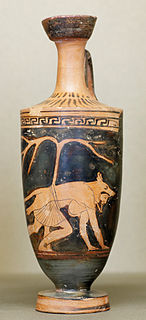 W
WIn Greek mythology, Dolon fought for Troy during the Trojan War.
 W
WIn Greek mythology, Euphorbus was a Trojan hero during the Trojan War.
 W
WIn Greek mythology, Ganymede or Ganymedes is a divine hero whose homeland was Troy. Homer describes Ganymede as the most beautiful of mortals, abducted by the gods, to serve as Zeus's cup-bearer in Olympus.[Ganymedes] was the loveliest born of the race of mortals, and thereforethe gods caught him away to themselves, to be Zeus' wine-pourer,for the sake of his beauty, so he might be among the immortals.
 W
WA Hardware Trojan (HT) is a malicious modification of the circuitry of an integrated circuit. A hardware Trojan is completely characterized by its physical representation and its behavior. The payload of an HT is the entire activity that the Trojan executes when it is triggered. In general, Trojans try to bypass or disable the security fence of a system: for example, leaking confidential information by radio emission. HT's also could disable, derange or destroy the entire chip or components of it.
 W
WHecuba was a queen in Greek mythology, the wife of King Priam of Troy during the Trojan War, She had 19 children, who included major characters of Homer's Iliad such as the warriors Hector and Paris, as well as the prophetess Cassandra. Two of them, Hector and Troilus, are said to have been born as a result of Hecuba's relationship with the god Apollo.
 W
WIn Greek mythology, Helenus was a gentle and clever seer. He was also a Trojan prince as the son of King Priam and Queen Hecuba of Troy, and the twin brother of the prophetess Cassandra. He was also called Scamandrios, and was a lover of Apollo.
 W
WIn Greek mythology and later art, the name Hesione refers to various mythological figures, of whom the Trojan princess Hesione is most known.
 W
WLaocoön, the son of Acoetes, is a figure in Greek and Roman mythology and the Epic Cycle. He was a Trojan priest who was attacked, with his two sons, by giant serpents sent by the gods. The story of Laocoön has been the subject of numerous artists, both in ancient and in more contemporary times.
 W
WThe Laocoön is an oil painting created between 1610 and 1614 by Greek painter El Greco. It is part of a collection at the National Gallery of Art in Washington, D.C..
 W
WIn Greek mythology, as recorded in Homer's Iliad, Lycaon was a son of Priam and Laothoe, daughter of the Lelegian king Altes.
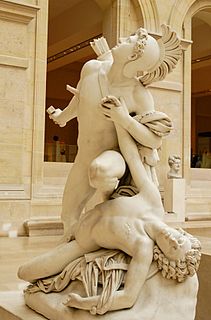 W
WIn Greek and Roman mythology, Nisus and Euryalus are a pair of friends and lovers serving under Aeneas in the Aeneid, the Augustan epic by Virgil. Their foray among the enemy, narrated in Book nine, demonstrates their stealth and prowess as warriors, but ends as a tragedy: the loot Euryalus acquires attracts attention, and the two die together. Virgil presents their deaths as a loss of admirable loyalty and valor. They also appear in Book 5, during the funeral games of Anchises, where Virgil takes note of their amor pius, a love that exhibits the pietas that is Aeneas's own distinguishing virtue.
 W
WPandarus or Pandar is a Trojan aristocrat who appears in stories about the Trojan War.
 W
WIn Greek mythology, Phorbas, or Phorbaceus, may refer to:Phorbas of Elis, son of Lapithes and Orsinome, and a brother of Periphas Phorbas, son of Triopas and Hiscilla, daughter of Myrmidon Phorbas, king of Argos, father of a different Triopas who succeeded him as king Phorbas, a shepherd of King Laius, who found the infant Oedipus on the hillside and ensured his survival to fulfill his destiny. A number of sculptures, ranging from the 14th to the 19th century, memorialize Phorbas' rescue of Oedipus. He might be the same as Phorbas, attendant of Antigone. Phorbas, listed as a king or archon of Athens Phorbas of Lesbos, father of Diomede Phorbas of Troy, who was favored and made rich by Hermes. He had a son Ilioneus, who was killed by Peneleos. Phorbas, son of Metion of Syene, who fought on Phineus' side against Perseus Phorbas of Acarnania, son of Poseidon, who went to Eleusis together with Eumolpus to fight against Erechtheus, and was killed by the opponent Phorbas, one of the twelve younger Panes Phorbas, son of Helios and father of Ambracia. Ambracia could also have been daughter of Augeas, granddaughter of Phorbas of Thessaly. Phorbas, who is called father of Tiresias by the Cretans Phorbas, charioteer of Theseus Phorbas, father of Dexithea who, according to one version, was the mother of Romulus and Remus by Aeneas
 W
WIn Greek mythology, Polites was the legitimate son of King Priam and Queen Hecuba and was known for his swiftness. He was a prince of Troy, and brother of 49 other children, including 12 daughters. He was killed by Neoptolemus (Pyrrhus), son of Achilles, who then killed his father. He is also known by his family as "- defender of Troy." [5] as well as having many siblings and being a prince of Troy.
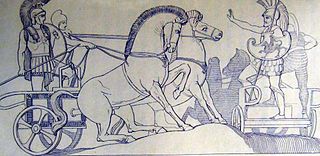 W
WIn Greek mythology, Polydamas was a lieutenant and friend of Hector during the Trojan War.
 W
WPolydorus or Polydoros is the youngest son of Priam in the mythology of the Trojan War. While Homer states his mother is Laothoe, later sources state his mother is Hecuba. Polydorus is an example of the fluid nature of myth, as his role and story vary significantly in different traditions and sources.
 W
WIn Greek mythology, Polyxena was the youngest daughter of King Priam of Troy and his queen, Hecuba. She does not appear in Homer, but in several other classical authors, though the details of her story vary considerably. After the fall of Troy, she dies when sacrificed by the Greeks on the tomb of Achilles, to whom she had been betrothed and in whose death she was complicit in many versions.
 W
WIn Greek mythology, Priam was the legendary king of Troy during the Trojan War. His many children included notable characters like Hector and Paris.
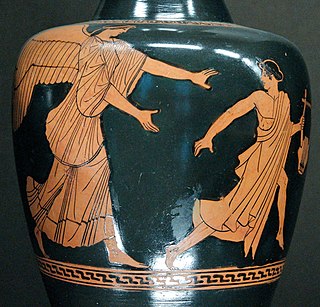 W
WIn Greek mythology, Tithonus was the lover of Eos, Goddess of the Dawn. He was a prince of Troy, the son of King Laomedon by the Naiad Strymo (Στρυμώ). The mythology reflected by the fifth-century vase-painters of Athens envisaged Tithonus as a rhapsode, as attested by the lyre in his hand, on an oinochoe of the Achilles Painter, circa 470–460 BC.
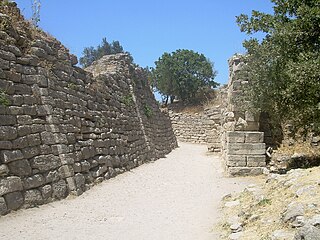 W
WThe Troada or Troad, or Troas, is the historical name of the Biga Peninsula in the northwestern part of Anatolia, Turkey. This region now is part of the Çanakkale province of Turkey. Bounded by the Dardanelles to the northwest, by the Aegean Sea to the west and separated from the rest of Anatolia by the massif that forms Mount Ida, the Troad is drained by two main rivers, the Scamander (Karamenderes) and the Simois, which join at the area containing the ruins of Troy.
 W
WTroilus is a legendary character associated with the story of the Trojan War. The first surviving reference to him is in Homer's Iliad, which some scholars theorize was composed by bards and sung in the late 9th or 8th century BC.
 W
WUcalegon was one of the Elders of Troy, whose house was set afire by the Achaeans when they sacked the city. He is one of Priam's friends in the Iliad, and the destruction of his house is referred to in the Aeneid.